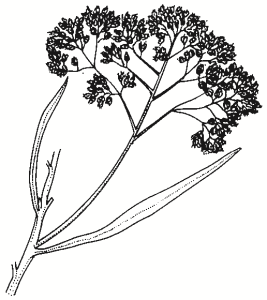Family:
Asteraceae
Cassinia longifolia
Shiny Cassinia
Other Names: Dogwood, Cauliflower Bush

Name Origin:
Cassinia — after French botanist Count Alexandre Henri Gabriel de Cassini (1781-1832).
Regional Subspecies:
Similar Species:
Distinguish Cassinias by leaves. Common Cassinia (C. aculeata subsp. aculeata) has shorter and more narrow leaves than Shiny Cassinia, and a different flowering time.
Occurrence:
Regional:
Noted mainly east of the Olympic Highway, and south of Billabong Creek.
Australia:
NSW, Vic, Tas.
Habitat:
Sclerophyll forest, woodland and heath on sandy or gravely soils.
Habit:
Erect, aromatic and sticky shrub 1.2 – 2.5 m high with narrow dark-green leaves 4-8 cm long.
Site Preference:
Moist, well-drained soil and semi-shade. Tolerates dry soil, full sun and drought.
Characteristics:
Fast-growing pioneer. Short-lived. Adaptable. Flowers may cause dermatitis.
Flowering:
Creamy white or straw coloured, summer-autumn.
Seed Collection:
Early Jan to late Feb. Seeds released 3-14 days after maturity. Cut seed-bearing heads off and dry in paper bag. Break up seedhead and sieve to extract seed.
Propagation:
From seed or cuttings. Surface-sow fine seed and cover lightly. Seedlings very small and may be difficult to handle. Direct sowing into pots recommended. Take cuttings about 15 cm long with heels in summer.
Regeneration:
From seed after disturbance. Establishes very well when direct seeded.
VALUES:
Shade & Shelter:
Useful for quick low-level cover in windbreaks.
Land Protection:
Colonises bare sites.
Wildlife:
May be food source for native birds including the Red-rumped Parrot, Turquoise Parrot, Yellow Rosella and Eastern Rosella.
Ornamental:
Valuable screen and specimen due to long, prolific flowering. Remove old flowerheads and prune heavily to promote flowering and dense growth.
Other:
Foliage used in cut flower arrangements.
